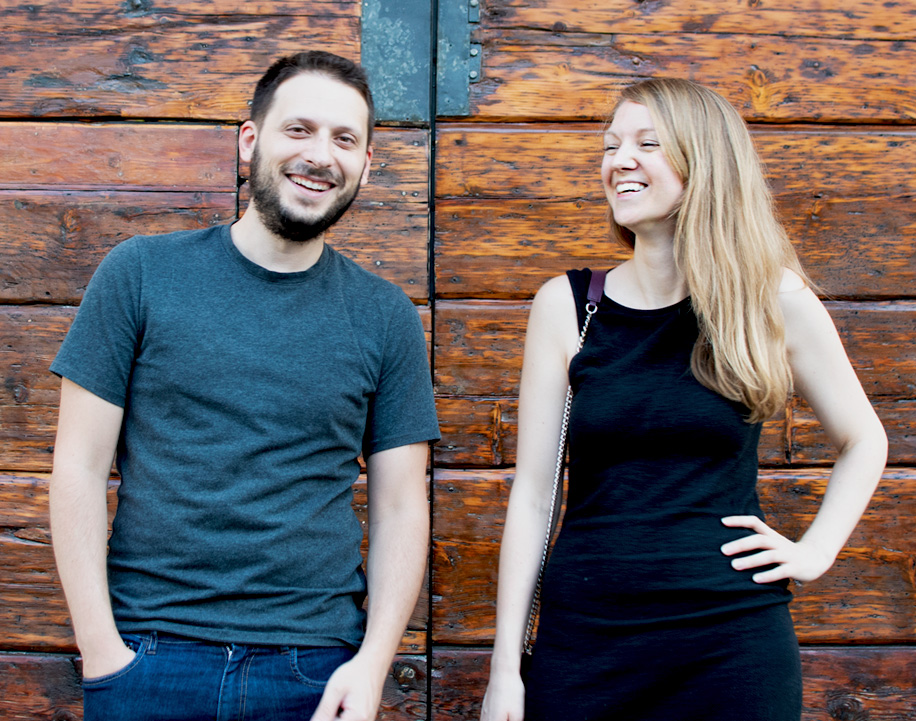Katie Harris and Matteo Alabisi are the smiling faces behind Easy Italian, a YouTube channel dedicated to giving viewers an authentic language-learning experience. With a mix of street interviews and easy-to-follow explanations, Matteo and Katie give us not only a fantastic tool for improving our Italian but a lively and entertaining insight into what life is like in Milan.
Easy Italian is part of Easy Languages. How does it all work?
Katie: The main idea of Easy Languages is street interviews. It’s a way of showing learners how people actually talk because textbooks can be so wooden. You know the classic thing where you learn a language at school, and then you go to the country and hear people speaking it and it sounds like a totally different language. That’s where Easy Languages comes in. It tries to actually show how native speakers speak the language on the street.
How did you get involved?
K: I used to use Easy German and became obsessed with it. Because they’re bite-sized videos, they’re easy to study. When I started learning Spanish I used Easy Spanish a lot. The guy who used to do Easy Spanish is called Juan – I got to know him. We were in Barcelona in a bar and the conversation moved onto how nobody was doing Easy Italian and someone should take it up.
Matteo: So we just thought… why not?
K: We’d thought about it before but we knew that if you do it, you really have to do it. There’s a lot of work involved and you have to be consistent to produce videos every week. After the conversation with Juan, we started thinking about it more seriously. I came back and mentioned it to Matteo, and he was the one who was more…
M: At the time I was working full time, so I thought, “Interesting, who knows? Maybe one day I can work fully for Easy Italian.” I’m a graphic designer, and the video and editing part was something interesting to me.

Especially in the videos you have posted since the start of the pandemic, we really get a view into life – and into your apartment! How do you feel putting your relationship on screen like that?
K: On the one hand, it’s a natural choice – this is who we are so we don’t have another option! On the other hand, it’s a philosophical choice. I have worked as an English teacher and an Italian teacher, and one thing that is strange and irritating is that a lot of language learning materials focus only on learning vocabulary and grammar rules. They strip languages of the thing that’s most interesting, which is communicating with real people. The most motivating thing about learning a language is being able to communicate with real people, so we want to show ourselves as real people.
How did you meet?
M: We were in Milan. I came here in 2010 from Naples to work as a graphic designer. I stayed with a friend who had moved to Milan six months before me. This friend knew another friend who knew Katie.
Obviously, in your videos, you only speak Italian. With each other, do you speak more Italian or English?
M: Mostly Italian, because Katie doesn’t want to speak English!
K: I deliberately looked for a boyfriend who didn’t speak English… and then he learned English! Now it depends on the mood. Italian’s our main language of communication, but if we’re joking around we may speak English.
How do you decide on the topics you’ll cover?
M: Sometimes we decide when we go to the place to shoot. Katie also had a list of things that she wants to show, so it depends. We often take ideas from other Easy Languages channels, so we know more about what will happen if we ask certain questions. When we shoot at home, Katie has to write the script – it’s just us so we have to be more careful about how we say something, how we want to teach something. The easy part is just to be funny and improvise, which we almost always do.
K: One thing we try and keep in mind when we’re choosing – and it’s not always easy, sometimes we sit for hours at a bar trying to decide! – is what might be interesting for someone who doesn’t live in Italy, to know about or to think about that they might not have thought about before.
When you approach people in the street, how do they usually respond?
K: It depends on where we are. Parks are good places because people aren’t busy, and Saturday mornings are easy because people don’t have places to go to. Obviously, lots of people say no. Which is fine! We’ve said before that we would both say no.
M: We would probably say yes now! We know that it’s not nice to say no, but we probably would have done a few months ago.
Matteo, you’re from Naples. Living in Milan, what are the biggest differences you notice?
M: Compared to Naples, people are less communicative with strangers in Milan: if you don’t know someone, you just walk past. In Naples, everyone is really talkative with everyone. It’s difficult to feel alone because you’re always talking to someone; if you look really sad, someone will ask you why you’re sad. Everyone in Milan keeps to themselves. But it’s much more organised as a city. I’m not saying it’s bad or good, but it is what it is.
Which do you prefer?
M: After 10 years, I prefer Milan as a place to live as an adult. I love Naples and I love going there, but – maybe because I lived there for 27 years – I wouldn’t live there now. I had my life there; here I’m building another life. Milan is very easy to live in: it’s small, but it’s a major European city. You have everything, but it’s all really close to you, even your friends.
K: There are things about Naples and its culture that are fantastic – ways we’ve forgotten to live in faster-paced places. For example, there’s still the culture of dropping by you’re just at home, the doorbell rings and then they stay for three or four hours!
Katie, what are the differences between Milan and your hometown in England?
K: Sometimes I joke that Milan and Sheffield are more similar than you’d expect because they’re both really grey and industrial! I really didn’t like Milan. I’d visited as a tourist before moving here and found it… grey and industrial. Then I lived here for about a month to do a teacher training course. In that month, I had the chance to live in Milan rather than just visit. That’s when I started to really appreciate life in Milan. It’s definitely not as nice as Rome or other pretty little Italian towns with cobbled streets – it can be a bit of a concrete jungle as soon as you go out of the centre. But it’s a really nice place to live. There are always things going on, but it’s not too big compared to somewhere like Rome, Paris or London.
Who are the people learning Italian?
K: There are a lot of people in the Baby Boomer generation. They’re just coming into retirement age, they’re still healthy and have time and money to travel; a lot of that generation want to learn Italian so when they come here they can enjoy it more. A lot of Americans with Italian families as well. There are younger people too, and people from all over. Some people want to live in Italy, some just love languages, some love Italian culture. I also have a business called Joy of Languages, and we have Italian courses. It’s the same philosophy, using true stories and pulling out grammatical explanations. There’s a lot of crossovers.
For people trying to learn Italian, what do you think are the most challenging hurdles to get over?
K: The most common answer to this is about the grammar, like memorising all the verbs… In reality, the most challenging bit of any foreign language is putting it all into practice. If you listen a lot and you speak a lot, the verbs will come with time, because you’ll hear people using the most common ones over and over again. If you practice speaking you’ll try and use them, you’ll get them wrong, people will give you feedback and you’ll learn better for next time. People get side-tracked thinking, “Oh, the grammar’s so complicated!” but the most challenging yet most effective thing is trying to use the language as much as possible in natural ways – so listening as much as possible and trying to speak.
M: The thing that I have noticed a lot is that, with the people doing our courses, they know things but they are scared to make mistakes so they get stuck. So that’s the most complicated thing – to forget the mistakes and just try to talk.
K: I still make mistakes, too. I used to think people I heard speaking fluently could speak it perfectly, but in my experience, it doesn’t work like that.
M: I still make mistakes in Italian too!
K: There are things you don’t really learn in your native language or you forget very easily. So there are lots of things like that for me in English.
What are the best and worst things about living in Italy?
K: The thing that I absolutely love about Italy is that, compared to a lot of other countries, Italy has really held onto important traditions for people living together and for mental health. Italians are really sociable, they always stop to eat together twice a day. You never feel lonely – nothing is so important that you can’t drop it to have a conversation. The flipside of that is that everyone pays so much attention to everyone else’s business! In British culture, people are a lot more live-and-let-live, so it’s a big adjustment to have people so interested in what you’re doing. It comes with a lot of social pressure too.
M: I would agree. I would say that the weather is something that is really difficult to have somewhere else. Also, you are really close to everything you would really want to do, wherever you are in Italy.
K: Mountains, lakes…
M: Cities… Every region has everything pretty much. And—wait, we forgot food. We can’t not mention the food. I can’t. I’m Neapolitan.





